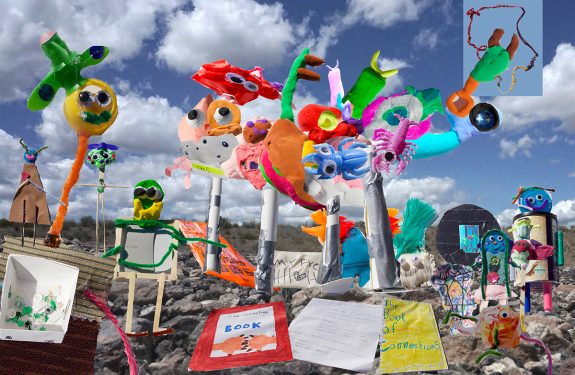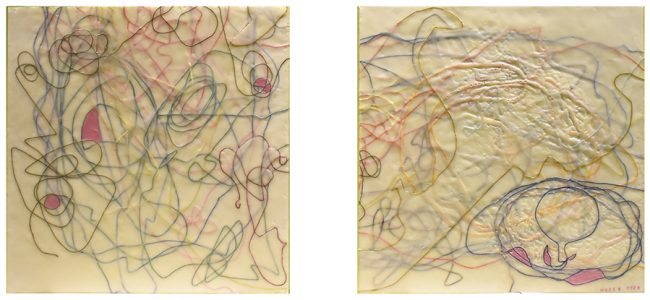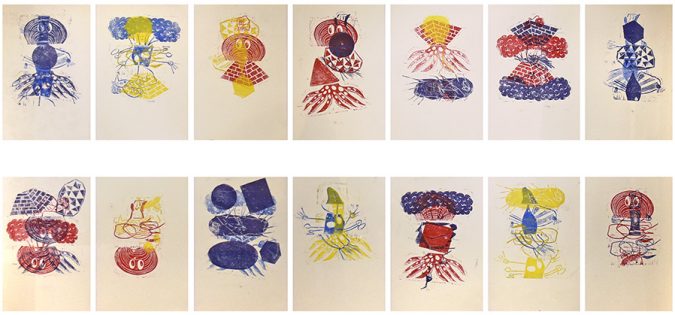The Co-Creation Project 2020
Foothills School of Arts and Sciences
+
Artist Teal Gardner
Foothills School of Arts and Sciences with Teal Gardner
The Connection from Another Planet, 2020
Air dry clay, fabric, paper, sticks, googly eyes, duct tape, acrylic fabric, pipe cleaners, foam, sequins, yarn, feathers, jewels, stuffing, containers, applesauce lids, popsicle sticks, plastic bugs, hot glue, sewing
Student Interview
Teal Gardner is a multi-disciplinary artist and a non-traditional educator whose interests range from free play and public space, to microbes and interspecies interdependence, with many whorls and tangents texturing the in-between. Her work has been supported by the Bemis Center for Contemporary Art, the Union for Contemporary Art, The Creative Sanctuary, and The Alexa Rose Foundation. She is an Alumnus of the University of Nebraska, Lincoln.
THE CO-CREATION
Foothills students were exploring the question, How do Connections Make Things Stronger?, when local artist, Teal Gardner, met with Foothills teachers to begin planning for The Co-Creation Project. The team talked about Teal’s ideas for projects that would highlight the ideas of children and allow for a creative, collaborative project.
Teal sat with each student and asked them what it means to connect. Students mentioned people connecting together by holding hands, dendrites connecting in the brain, relating new learning to previous experiences, intertwining tree branches supporting birds’ nests, and creating a larger image from smaller puzzle pieces.
After this discussion, Teal laid out a large piece of cloth and told the students that each person could make a continuous line with fabric markers somewhere on the cloth. Everyone watched as each student made their lines. Some drew figures or recognizable things, like people holding hands. Teal asked the group to imagine the drawing as an alien from outer space that does not know how to connect—it cannot see, or hear, or make friends because it cannot connect.
Teal tasked the kids with creating something that would enable the alien to connect while it is on earth. Many chose to use air dry clay. Some chose found objects and hot glue. Others used fabric or paper to construct. They made friends for the alien, resource books on how to connect, and a body complete with skin for the alien. Some students created specific body parts they deemed important for connecting, like eyes, ears, and mouths. Many students began creating food objects for the alien. Students were exploring the ways food connects us socially and comprises us physically.
Teal photographed their creations, and at her next visit, she showed the students the ways she was able to change the size of each piece to fit them into a collaborative collage. It was easy for students to find their original draw-lines. Teal and the students were very excited at every stage of this process, and worked together with passion and creativity.
Student Interview
Heather Bee is an encaustic artist, writer, and former elementary and art studio teacher. For seven years, she has been working in the medium of wax encaustic, an ancient art form involving the painting of molten beeswax and tree sap, and often including pigment and various other media. She is inspired and informed by patterns and forms in nature, as well as the mystical and unknown. Bee also draws much inspiration from children — their inquisitive encounters with the world, and their keen recognition of the new and fascinating.
THE CO-CREATION
The students in this class love to move their bodies; they are active and interested in new ways of moving. This project began by introducing the ideas of intentional movement and tracing movement.
When Heather Bee learned that this class was interested in movement, she was reminded of Japanese contemporary artist, Yukinori Yanagi. By following the trail of an ant with a red pencil, Yanagi created artwork inspired by movement. After sharing Yanagi’s process and art with the children, some questions were posed, such as: “what if you were the ant?”, and “would you be able to follow your own path?” The children had a lot of exuberant responses and were clearly excited about this idea.
They first had the opportunity to follow the path of a laser pointer light on paper with a colored marker. In class they followed the laser point light with their fingers in sand, then on the carpet, with their bodies. Next, Heather Bee filmed a number of sessions during which the children moved around a defined space — playing with scarves and bean bags, and dancing to music. The video was projected onto paper, and the children each found themselves, and traced their paths onto the paper. They each selected a different color of embroidery thread, and Bee used the thread to mark select pieces of the traced paths into the encaustic work. The result is a visually cacophonous representation of each of their 16 movements, coded in color and layered in wax.
Wesleyan Preschool & Kindergarten with Colin Pinegar
Exquisite, 2020
water-based printing ink on paper
Student Interview
Colin Pinegar is a graphic designer and illustrator, living, learning, and working from home in Boise, Idaho. In a world where more and more people leverage the value of design as a way to make money, he likes to challenge the flat, corporate aesthetic by injecting a bit of whimsy, imperfection, and play into the stodgy world of profits, ads, logos, and e-commerce. Pinegar’s considers his design, illustration, and other projects successful if they get people to think, laugh, and generally lighten up.
THE CO-CREATION
This collaboration began with two of the class’s favorite books, If… by Sarah Perry and Oh! by Josse Goffin. If… is funny, and Perry’s colorful descriptions inspired this project. The illustrations connect and morph from one to the next as the book is read. For instance, a teacup unfolds to become the bow of a large ship. The students were fascinated by this idea of an image that starts as one object and unfolds, becoming something else.
Colin introduced the drawing approach used in Oh!, known as Exquisite Corpse, to the class. Exquisite Corpse is a type of chain game played by surrealist artists like Anna Riwkin, Man Ray, Salvador Dali, and Yves Tanguy. The game began with a sheet of paper folded into thirds. Each student drew a ‘head’ on the top third of the paper, folding it afterward so that it was not visible and passing it to a friend. The next student drew the ‘body’ in the second third of the paper, folded it, and passed the paper again. The next student completed the artwork by drawing ‘feet’ in the bottom third of the paper. The students’ collaborative creations became the foundational images for this artwork. Students reflected, “I added arms that are carrying a monster;” “That’s hilarious! I added stripes;” “A cow with a noodle mouth! And broccoli feet!;” “Want to see mine? Be careful opening it. The spikes are sharp!”
Colin transferred the folded drawings into carved linoleum blocks. Each child chose which blocks they wanted to use and how they wanted to arrange them. The students then used printmaking tools to ink the blocks and print on poster paper. Colin termed this part of the project “making magic,” and the printing was the children’s favorite part of the co-creation process.
The results were exciting, playful, and silly. Each child produced one final poster, including their drawing as a blockprint, along with carved drawings, produced by their classmates and the teacher. They used the same pieces, but each poster is original, bright, and playful—a reflection of the artists themselves! The students learned art can be a collaborative process that results in magical and unforeseen outcomes.




